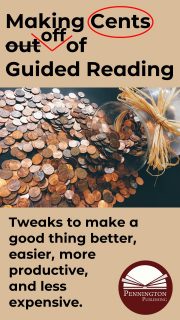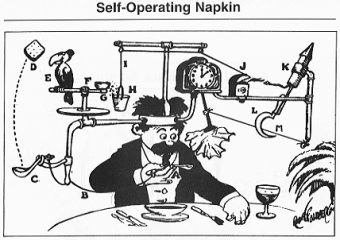Making Sense of Guided Reading
The key idea of guided reading: to make sure kids are being taught from books that are not too far beyond their skills certainly makes sense. According to Vygotsky, students learn best when they are provided strong instructional support to extend themselves by reading texts that are on the edge of their learning—not too easy but not too hard*. And guided reading publishers attempt to do just that by putting reading level theory into practice. Most teachers have bought into guided reading hook, line, and sinker.
Most elementary teachers in the United States use one form of guided reading or another. In fact, the two most popular reading programs (Fountas & Pinnell and Teacher’s College Readers Workshop) which account for more than 60% of reading program sales in the United States use leveled books as the core component of their curricula.
However, you can take even a good idea too far in terms of adherence to a theoretic framework and implementation in the classroom.
First, in terms of a theoretic framework, the simple fact is that the science behind reading levels theory is quite a squishy notion. Specifically, we have mistakenly assumed that independent, instructional, and frustration reading levels are research-based and quantifiable constructs.
Dr. Tim Shanahan took a look at the original research regarding reading levels theory:
Made famous in Emmett Betts’s influential, now-little-remembered 1946 textbook Foundations of Reading Instruction, leveled reading theory actually emerged from a more obscure study conducted by one of Betts’s doctoral students. “I tracked down that dissertation and to my dismay it was evident that they had just made up those designations without any empirical evidence,” Shanahan wrote. When the study—which had in effect never been conducted—was “replicated,” it yielded wildly different results. In other words, there was no study, and later research failed to show the benefits of leveling. “Basically we have put way too much confidence in an unproven theory,” Shanahan concluded (https://fordhaminstitute.org/national/commentary/leveled-reading-making-literacy-myth).
Second, in terms of leveled reading instruction, implementation of the reading levels theory via guided reading is challenging, time-consuming, expensive, and provides less student-teacher reading time because of the narrowly focused guided reading groups.
In fact, the commonly-accepted notion about reading levels has produced a Rube Goldberg machine in reading instruction. A Rube Goldberg machine, named after American cartoonist Rube Goldberg, is a machine intentionally designed to perform a simple task in an indirect and overly complicated way (https://en.wikipedia.org/wiki/Rube_Goldberg_machine).
The Fountas &Pinnell A to Z readers are such a machine. The differences among the levels are virtually indistinguishable, but the levels are goldmines for the publishers. More levels = more profit. As Tim Shanahan remarks,
“Teachers sacrifice way too much instructional time trying to provide kids teaching at their exact level. So, you’ll see teachers spending 15-20 minutes each with groups at level “L” and “M” that frankly aren’t different. In such cases, the teacher would be better off spending 30-40 minutes with the two combined groups (https://shanahanonliteracy.com/blog/the-problem-with-guided-reading).
My suggestions to make sense of guided reading:
- No need to throw the baby out with the bathwater. I’m not suggesting, as many in the science of reading group advocate, getting rid of guided reading. The structural and instructional components of flexible ability grouping, meaningful busy work for rest of kids, reading with the teacher on a daily basis, and authentic assessment via running records are effective instructional strategies; however a few tweaks are in order.
- Rather than trying to fine tune your guided reading groups by adding more discrete reading level groups, think of combining groups to maximize instructional minutes, minimize independent work, and improve behavior management. Especially consider doubling the size of the teacher-led guided reading group and reducing the number of total groups. Check out these group rotation ideas.
- Look to other means of assessment to determine reading needs and group placements, in addition to running records. Teachers don’t like to hear this, but we are not completely objective evaluators. According to Dr. Louisa Moats, “The reliability of oral reading tests and running records is lower than the reliability of more structured, specific measures of component reading skills. Teacher judgment of the cause of specific oral reading errors (e.g., miscue analysis) tends to be much less reliable” (https://www.aft.org/sites/default/files/reading_rocketscience_2004.pdf) Louisa
- In addition to leveled reading groups, use these alternative assessment data to drive instruction within your guided reading group stations. Flexible groupings can teach r-controlled vowels to a group, or the soft /c/ spellings, or non-decodable sight words, etc. to needs-based groups, formed according to diagnostic assessments.
The benefits of these guided reading tweaks…
- Fewer groups means less prep for guided reading groups and other independent learning stations.
- Less wasted instruction. When teachers notice reading errors during guided reading or running records which they wish to address via mini-lessons, some, but not all students will benefit.
- Targeted needs-based instruction is more efficient than mini-lessons.
- Students will progress quicker with the addition of assessment-based instruction.
- Less $
- Less tracking. Traditional guided reading groups stay quite similar from the start to end of the school year, with notable exceptions.
- Better behavior management. With fewer groups, fewer transitions are necessary. With more students in the teacher’s group, less idle hands are making mischief.
- More teacher-student time.
*****
Check out the Sam and Friends Guided Reading Phonics Books in the author’s program below to add an assessment-based phonics practice component to your guided reading.
Get the Diagnostic Reading and Spelling Assessments FREE Resource:

The Science of Reading Intervention Program
The Science of Reading Intervention Program: Word Recognition includes explicit, scripted instruction and practice with the 5 Daily Google Slide Activities every reading intervention student needs: 1. Phonemic Awareness and Morphology 2. Blending, Segmenting, and Spelling 3. Sounds and Spellings (including handwriting) 4. Heart Words Practice 5. Sam and Friends Phonics Books (decodables). Plus, digital and printable sound wall cards and speech articulation songs. Print versions are available for all activities. First Half of the Year Program (55 minutes-per-day, 18 weeks)
The Science of Reading Intervention Program: Language Comprehension resources are designed for students who have completed the word recognition program or have demonstrated basic mastery of the alphabetic code and can read with some degree of fluency. The program features the 5 Weekly Language Comprehension Activities: 1. Background Knowledge Mentor Texts 2. Academic Language, Greek and Latin Morphology, Figures of Speech, Connotations, Multiple Meaning Words 3. Syntax in Reading 4. Reading Comprehension Strategies 5. Literacy Knowledge (Narrative and Expository). Second Half of the Year Program (30 minutes-per-day, 18 weeks)
The Science of Reading Intervention Program: Assessment-based Instruction provides diagnostically-based “second chance” instructional resources. The program includes 13 comprehensive assessments and matching instructional resources to fill in the yet-to-be-mastered gaps in phonemic awareness, alphabetic awareness, phonics, fluency (with YouTube modeled readings), Heart Words and Phonics Games, spelling patterns, grammar, usage, and mechanics, syllabication and morphology, executive function shills. Second Half of the Year Program (25 minutes-per-day, 18 weeks)
The Science of Reading Intervention Program BUNDLE includes all 3 program components for the comprehensive, state-of-the-art (and science) grades 4-adult full-year program. Scripted, easy-to-teach, no prep, no need for time-consuming (albeit valuable) LETRS training or O-G certification… Learn as you teach and get results NOW for your students. Print to speech with plenty of speech to print instructional components.



